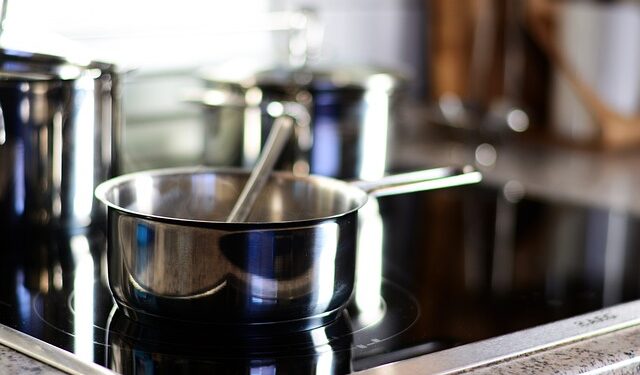Electric hobs are a must-have in today’s kitchens, offering sleek designs and efficient cooking capabilities. Whether you’re preparing quick meals or experimenting with new recipes, keeping your hob in great condition is important for its performance and longevity. This guide will provide practical tips for cleaning and maintaining your hob, discuss common problems, and explore when professional help might be needed.
1. Types of Electric Hobs
Electric hobs come in two main varieties: ceramic and induction. Each type has unique features that cater to different cooking needs:
-
Ceramic Hobs: These have smooth glass surfaces that heat evenly and are easy to clean. They’re a popular choice for their affordability and stylish appearance.
-
Induction Hobs: Using electromagnetic technology, these hobs heat only the cookware while keeping the surface cool to the touch. They’re energy-efficient and perfect for precise temperature control.
When choosing a hob, many people look to premium options from hob brands like BORA and Elica, which combine innovative features with elegant designs that elevate any kitchen space.
2. Cleaning and Maintenance Tips
Regular maintenance is key to keeping your hob functioning at its best. Here are some simple but effective practices:
Daily Cleaning
-
Allow the hob to cool completely before cleaning.
-
Use a soft cloth or sponge with warm soapy water to wipe away spills and grease.
-
Avoid abrasive materials or harsh chemicals that could damage the surface of ceramic or induction hobs.
Removing Stubborn Stains
-
For burnt-on food, gently scrape residue using a hob scraper designed for glass surfaces.
-
Apply a specialized hob cleaner or a paste made from baking soda and water to lift tough stains without scratching the surface.
Preventing Scratches
-
Always lift pots and pans instead of sliding them across the surface to avoid scratches.
-
Check the bottoms of cookware for debris or rough edges that could harm the glass finish.
3. Common Problems and Repairs
Even with proper care, electric hobs can develop issues over time. Some common problems include:
-
Uneven Heating: This may indicate a faulty heating element or sensor.
-
Cracked Glass Surface: A damaged surface can compromise safety and should be addressed immediately.
-
Unresponsive Controls: Often caused by electrical faults or wear on the control panel.
If you encounter any of these issues, seeking professional help for electric hob repairs is often more cost-effective than replacing the appliance entirely. Skilled technicians can diagnose problems quickly and restore your hob’s functionality.
4. Energy-Saving Tips for Your Hob
Energy efficiency is an important consideration when using any kitchen appliance. Here’s how you can reduce energy consumption while cooking:
-
Use cookware with flat bottoms that match the size of the cooking zone to minimize heat loss.
-
For induction hobs, ensure your pots and pans are magnetic-compatible for optimal performance.
-
Turn off cooking zones slightly before finishing as residual heat can complete the process efficiently.
-
Regularly clean gas burners or induction coils to maintain consistent heat output.
These small changes can have a big impact on reducing your energy bills over time.
5. When Should You Consider Upgrading?
While maintenance and repairs can extend the life of your hob significantly, there are times when upgrading might be a better option:
-
The glass surface has extensive cracks or chips that compromise safety.
-
Heating elements fail repeatedly despite repairs.
-
You want access to modern features like bridge zones or integrated extraction systems.
-
Your current model is no longer energy-efficient compared to newer options.
Premium hob brands offer state-of-the-art models with advanced features such as downdraft extraction systems, touch controls, and energy-saving technologies—making them excellent choices for anyone looking to upgrade their kitchen appliances.
6. Sustainability in Kitchen Appliances
As sustainability becomes increasingly important in today’s homes, choosing eco-friendly appliances can make a difference in reducing waste and energy consumption:
-
Opt for hobs with high energy ratings (e.g., A+++) when purchasing new models.
-
Maintain your current hob properly to extend its lifespan instead of replacing it prematurely.
-
Recycle old appliances responsibly through local recycling programs or manufacturer take-back schemes.
By making thoughtful decisions about your kitchen appliances, you contribute to a greener planet while enjoying efficient cooking experiences.
Conclusion
Electric hobs are an integral part of any modern kitchen, combining functionality with sleek design. By following simple cleaning routines, addressing issues promptly through professional services like electric hob repairs, and exploring innovative options from hob brands like BORA and Elica when upgrading, you can enjoy years of reliable performance from this indispensable appliance.
Whether you’re preparing everyday meals or experimenting with culinary creations, a well-maintained electric hob will always be a valuable addition to your kitchen!





























